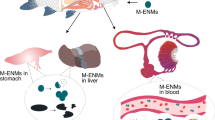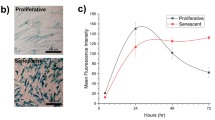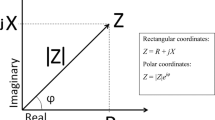Abstract
Our knowledge of uptake, toxicity and detoxification mechanisms as related to nanoparticles’ (NPs’) characteristics remains incomplete. Here we combine the analytical power of three advanced techniques to study the cellular binding and uptake and the intracellular transformation of silver nanoparticles (AgNPs): single-particle inductively coupled mass spectrometry, mass cytometry and synchrotron X-ray absorption spectrometry. Our results show that although intracellular and extracellularly bound AgNPs undergo major transformation depending on their primary size and surface coating, intracellular Ag in 24 h AgNP-exposed human lymphocytes exists in nanoparticulate form. Biotransformation of AgNPs is dominated by sulfidation, which can be viewed as one of the cellular detoxification pathways for Ag. These results also show that the toxicity of AgNPs is primarily driven by internalized Ag. In fact, when toxicity thresholds are expressed as the intracellular mass of Ag per cell, differences in toxicity between NPs of different coatings and sizes are minimized. The analytical approach developed here has broad applicability in different systems where the aim is to understand and quantify cell–NP interactions and biotransformation.
This is a preview of subscription content, access via your institution
Access options
Access Nature and 54 other Nature Portfolio journals
Get Nature+, our best-value online-access subscription
$29.99 / 30 days
cancel any time
Subscribe to this journal
Receive 12 print issues and online access
$259.00 per year
only $21.58 per issue
Buy this article
- Purchase on Springer Link
- Instant access to full article PDF
Prices may be subject to local taxes which are calculated during checkout




Similar content being viewed by others
Data availability
The data that support the findings reported in this study are available from the corresponding author upon reasonable request.
References
Piao, M. J. et al. Silver nanoparticles induce oxidative cell damage in human liver cells through inhibition of reduced glutathione and induction of mitochondria-involved apoptosis. Toxicol. Lett. 201, 92–100 (2011).
Beer, C., Foldbjerg, R., Hayashi, Y., Sutherland, D. S. & Autrup, H. Toxicity of silver nanoparticles—nanoparticle or silver ion? Toxicol. Lett. 208, 286–292 (2012).
Chen, D. & Yang, Z. Tissue toxicity following the vaginal administration of nanosilver particles in rabbits. Regen. Biomater. 2, 261–265 (2015).
McShan, D., Ray, P. C. & Yu, H. Molecular toxicity mechanism of nanosilver. J. Food Drug Anal. 22, 116–127 (2014).
Stensberg, M. C. et al. Toxicological studies on silver nanoparticles: challenges and opportunities in assessment, monitoring and imaging. Nanomedicine 6, 879–898 (2011).
Kettler, K., Veltman, K., van de Meent, D., van Wezel, A. & Hendriks, A. J. Cellular uptake of nanoparticles as determined by particle properties, experimental conditions, and cell type. Environ. Toxicol. Chem. 33, 481–492 (2014).
Sabella, S. et al. A general mechanism for intracellular toxicity of metal-containing nanoparticles. Nanoscale 6, 7052–7061 (2014).
Wang, Z. et al. Silver nanoparticles induced RNA polymerase-silver binding and RNA transcription inhibition in erythroid progenitor cells. ACS Nano 7, 4171–4186 (2013).
Park, E.-J., Yi, J., Kim, Y., Choi, K. & Park, K. Silver nanoparticles induce cytotoxicity by a Trojan-horse type mechanism. Toxicol. Vitr. 24, 872–878 (2010).
Setyawati, M. I., Yuan, X., Xie, J. & Leong, D. T. The influence of lysosomal stability of silver nanomaterials on their toxicity to human cells. Biomaterials 35, 6707–6715 (2014).
Gliga, A. R., Skoglund, S., Odnevall Wallinder, I., Fadeel, B. & Karlsson, H. L. Size-dependent cytotoxicity of silver nanoparticles in human lung cells: the role of cellular uptake, agglomeration and Ag release. Part. Fibre Toxicol. 11, 11 (2014).
Hsiao, I. L., Hsieh, Y.-K., Wang, C.-F., Chen, I. C. & Huang, Y.-J. Trojan-horse mechanism in the cellular uptake of silver nanoparticles verified by direct intra- and extracellular silver speciation analysis. Environ. Sci. Technol. 49, 3813–3821 (2015).
Ivask, A., Mitchell, A. J., Malysheva, A., Voelcker, N. H. & Lombi, E. Methodologies and approaches for the analysis of cell–nanoparticle interactions. Wiley Interdiscip. Rev. Nanomed. Nanobiotechnol. https://doi.org/10.1002/wnan.1486 (2018).
Ribeiro, F. et al. Uptake and elimination kinetics of silver nanoparticles and silver nitrate by Raphidocelis subcapitata: the influence of silver behaviour in solution. Nanotoxicology 9, 686–695 (2015).
Sekine, R. et al. Complementary imaging of silver nanoparticle interactions with green algae: dark-field microscopy, electron microscopy, and nanoscale secondary ion mass spectrometry. ACS Nano 11, 10894–10902 (2017).
Thorley, A. J., Ruenraroengsak, P., Potter, T. E. & Tetley, T. D. Critical determinants of uptake and translocation of nanoparticles by the human pulmonary alveolar epithelium. ACS Nano 8, 11778–11789 (2014).
Böhme, S., Stärk, H.-J., Kühnel, D. & Reemtsma, T. Exploring LA-ICP-MS as a quantitative imaging technique to study nanoparticle uptake in Daphnia magna and zebrafish (Danio rerio) embryos. Anal. Bioanal. Chem. 407, 5477–5485 (2015).
Drescher, D. et al. Quantitative imaging of gold and silver nanoparticles in single eukaryotic cells by laser ablation ICP-MS. Anal. Chem. 84, 9684–9688 (2012).
Hsiao, I. L. et al. Quantification and visualization of cellular uptake of TiO2 and Ag nanoparticles: comparison of different ICP-MS techniques. J. Nanobiotechnol. 14, 50 (2016).
Gilbert, B. et al. The fate of ZnO nanoparticles administered to human bronchial epithelial cells. ACS Nano 6, 4921–4930 (2012).
Ivask, A. et al. Complete transformation of ZnO and CuO nanoparticles in culture medium and lymphocyte cells during toxicity testing. Nanotoxicology 11, 150–156 (2017).
Jiang, X. et al. Fast intracellular dissolution and persistent cellular uptake of silver nanoparticles in CHO-K1 cells: implication for cytotoxicity. Nanotoxicology 9, 181–189 (2015).
Wang, L. et al. Use of synchrotron radiation-analytical techniques to reveal chemical origin of silver-nanoparticle cytotoxicity. ACS Nano 9, 6532–6547 (2015).
Bandura, D. R. et al. Mass cytometry: technique for real time single cell multitarget immunoassay based on inductively coupled plasma time-of-flight mass spectrometry. Anal. Chem. 81, 6813–6822 (2009).
Basiji, D. A., Ortyn, W. E., Liang, L., Venkatachalam, V. & Morrissey, P. Cellular image analysis and imaging by flow cytometry. Clin. Lab. Med. 27, 653–670 (2007).
Ivask, A. et al. Single cell level quantification of nanoparticle–cell interactions using mass cytometry. Anal. Chem. 89, 8228–8232 (2017).
Ivask, A. et al. Quantitative multimodal analyses of silver nanoparticle-cell interactions: implications for cytotoxicity. NanoImpact 1, 29–38 (2016).
Malysheva, A., Voelcker, N., Holm, P. E. & Lombi, E. Unraveling the complex behavior of AgNPs driving NP-cell interactions and toxicity to algal cells. Environ. Sci. Technol. 50, 12455–12463 (2016).
Peters, R. J. B. et al. Development and validation of single particle ICP-MS for sizing and quantitative determination of nano-silver in chicken meat. Anal. Bioanal. Chem. 406, 3875–3885 (2014).
Ivask, A. et al. Toxicity mechanisms in Escherichia coli vary for silver nanoparticles and differ from ionic silver. ACS Nano 8, 374–386 (2014).
Ivask, A. et al. Size-dependent toxicity of silver nanoparticles to bacteria, yeast, algae, crustaceans and mammalian cells in vitro. PLoS One 9, e102108 (2014).
Silva, T. et al. Particle size, surface charge and concentration dependent ecotoxicity of three organo-coated silver nanoparticles: comparison between general linear model-predicted and observed toxicity. Sci. Total Environ. 468-469, 968–976 (2014).
Turnbull, T. et al. Cross-correlative single-cell analysis reveals biological mechanisms of nanoparticle radiosensitization. ACS Nano 13, 5077–5090 (2019).
Klausen, L. H., Fuhs, T. & Dong, M. Mapping surface charge density of lipid bilayers by quantitative surface conductivity microscopy. Nat. Commun. https://doi.org/10.1038/ncomms12447 (2016).
Fröhlich, E. The role of surface charge in cellular uptake and cytotoxicity of medical nanoparticles. Int. J. Nanomed. 7, 5577–5591 (2012).
Lin, J. & Alexander-Katz, A. Cell membranes open “doors” for cationic nanoparticles/biomolecules: insights into uptake kinetics. ACS Nano 7, 10799–10808 (2013).
Ruenraroengsak, P. & Tetley, T. D. Differential bioreactivity of neutral, cationic and anionic polystyrene nanoparticles with cells from the human alveolar compartment: robust response of alveolar type 1 epithelial cells. Part. Fibre Toxicol. 12, 19 (2015).
Wang, C. et al. Cationic surface modification of gold nanoparticles for enhanced cellular uptake and X-ray radiation therapy. J. Mater. Chem. B 3, 7372–7376 (2015).
Milić, M. et al. Cellular uptake and toxicity effects of silver nanoparticles in mammalian kidney cells. J. Appl. Toxicol. 35, 581–592 (2015).
Yu, S.-J. et al. Quantification of the uptake of silver nanoparticles and ions to HepG2 cells. Environ. Sci. Technol. 47, 3268–3274 (2013).
Wang, S., Lv, J., Ma, J. & Zhang, S. Cellular internalization and intracellular biotransformation of silver nanoparticles in Chlamydomonas reinhardtii. Nanotoxicology 10, 1129–1135 (2016).
Brunetti, G. et al. Fate of zinc and silver engineered nanoparticles in sewerage networks. Water Res. 77, 72–84 (2015).
Wang, P. et al. Characterizing the uptake, accumulation and toxicity of silver sulfide nanoparticles in plants. Environ. Sci. Nano 4, 448–460 (2017).
Cotton, F. & Wilkinson, G. Advances in Inorganic Chemistry (John Wiley & Sons, 1980).
Stein, A. & Bailey, S. M. Redox biology of hydrogen sulfide: implications for physiology, pathophysiology, and pharmacology. Redox Biol. 1, 32–39 (2013).
Kimura, H. Production and physiological effects of hydrogen sulfide. Antioxid. Redox Signal 20, 783–793 (2014).
Vázquez Peláez, M., Costa-Fernández, J. M. & Sanz-Medel, A. Critical comparison between quadrupole and time-of-flight inductively coupled plasma mass spectrometers for isotope ratio measurements in elemental speciation. J. Anal. At. Spectrom. 17, 950–957 (2002).
Braun, G. B. et al. Etchable plasmonic nanoparticle probes to image and quantify cellular internalization. Nat. Mater. 13, 904–911 (2014).
Pace, H. E. et al. Single particle inductively coupled plasma-mass spectrometry: a performance evaluation and method comparison in the determination of nanoparticle size. Environ. Sci. Technol. 46, 12272–12280 (2012).
Ravel, B. & Newville, M. ATHENA, ARTEMIS, HEPHAESTUS: data analysis for X-ray absorption spectroscopy using IFEFFIT. J. Synchrotron Radiat. 12, 537–541 (2005).
Gräfe, M., Donner, E., Collins, R. N. & Lombi, E. Speciation of metal(loid)s in environmental samples by X-ray absorption spectroscopy: a critical review. Anal. Chim. Acta 822, 1–22 (2014).
Acknowledgements
We thank A. Mitchell for his help with Cy-TOF and S. Ritch and G. Brunetti for their help with ICP-MS. A part of the work was undertaken on the XAS beamline at the Australian Synchrotron, part of the Australian Nuclear Science and Technology Organisation (ANSTO). We acknowledge support for N.H.V. from the Melbourne Centre for Nanofabrication, the Victorian Node of the Australian National Fabrication Facility.
Author information
Authors and Affiliations
Contributions
N.H.V. and E.L. conceived the research. A.M. and A.I. designed and conducted the experiments and contributed equally to the experimental work. A.M., A.I. and C.L.D. analysed the experimental results. N.H.V. and E.L. supervised the project. A.M., A.I. and C.L.D. drafted the manuscript, and N.H.V. and E.L. provided input and revisions.
Corresponding author
Ethics declarations
Competing interests
The authors declare no competing interests.
Additional information
Peer review information Nature Nanotechnology thanks Qiangbin Wang and the other, anonymous, reviewer(s) for their contribution to the peer review of this work.
Publisher’s note Springer Nature remains neutral with regard to jurisdictional claims in published maps and institutional affiliations.
Supplementary information
Supplementary Information
Supplementary Tables 1 and 2 and Figs. 1–7.
Rights and permissions
About this article
Cite this article
Malysheva, A., Ivask, A., Doolette, C.L. et al. Cellular binding, uptake and biotransformation of silver nanoparticles in human T lymphocytes. Nat. Nanotechnol. 16, 926–932 (2021). https://doi.org/10.1038/s41565-021-00914-3
Received:
Accepted:
Published:
Issue Date:
DOI: https://doi.org/10.1038/s41565-021-00914-3
This article is cited by
-
Ag nanocomposite hydrogels with immune and regenerative microenvironment regulation promote scarless healing of infected wounds
Journal of Nanobiotechnology (2023)
-
Silver Nanoparticles Prepared Using Magnolia officinalis Are an Effective Antimicrobial Agent on Candida albicans, Escherichia coli, and Staphylococcus aureus
Probiotics and Antimicrobial Proteins (2023)
-
Engineering Janus gold nanorod—titania heterostructures with enhanced photocatalytic antibacterial activity against multidrug-resistant bacterial infection
Nano Research (2023)
-
Quantification of silver nanoparticle interactions with yeast Saccharomyces cerevisiae studied using single-cell ICP-MS
Analytical and Bioanalytical Chemistry (2022)
-
An Updated Review on Ag NP Effects at Organismal Level: Internalization, Responses, and Influencing Factors
Reviews of Environmental Contamination and Toxicology (2022)



